Essay on Post-Colonial Challenges in Sri Lanka's Development
VerifiedAdded on 2022/08/21
|6
|1351
|29
Essay
AI Summary
This essay delves into the multifaceted post-colonial challenges encountered by Sri Lanka after gaining independence from British rule. It highlights the initial challenges, including the country's continued association with the British Commonwealth and the transition to a republic. The essay explores the rise of ethnic conflicts between Sinhala and Tamil communities, leading to displacement and violence. It further examines cultural rivalries between religious groups and their impact on social cohesion. The essay also analyzes the economic challenges, such as the establishment of free trade zones and the exploitation of female workers. It also addresses issues of gender inequality, patriarchal structures, and the limited political freedom of women. The essay concludes by emphasizing the persistent challenges faced by Sri Lanka, particularly concerning minority rights and gender equality, even after the end of colonial rule, and its impact on the country's development. The essay references various academic sources to support its arguments.
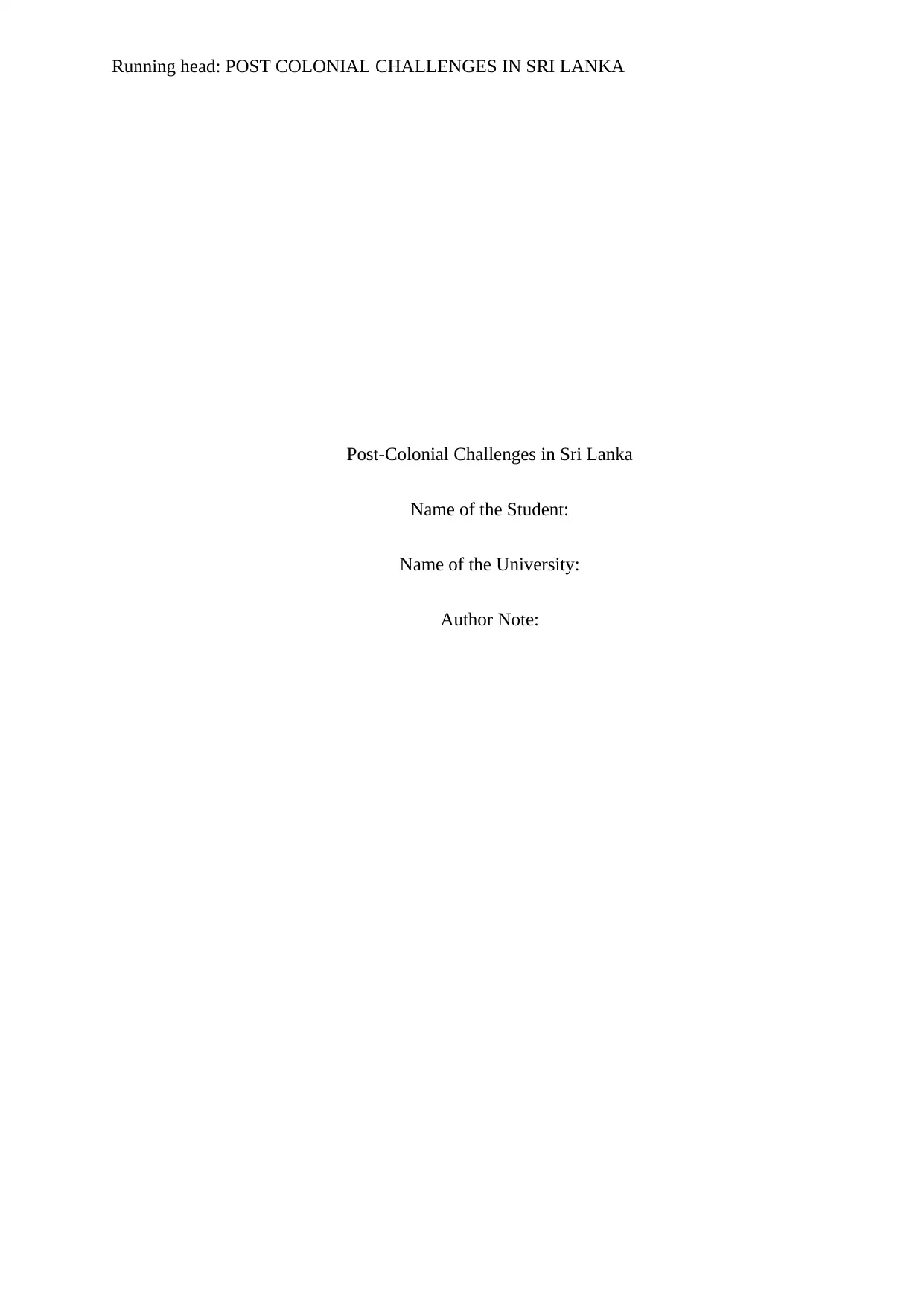
Running head: POST COLONIAL CHALLENGES IN SRI LANKA
Post-Colonial Challenges in Sri Lanka
Name of the Student:
Name of the University:
Author Note:
Post-Colonial Challenges in Sri Lanka
Name of the Student:
Name of the University:
Author Note:
Paraphrase This Document
Need a fresh take? Get an instant paraphrase of this document with our AI Paraphraser
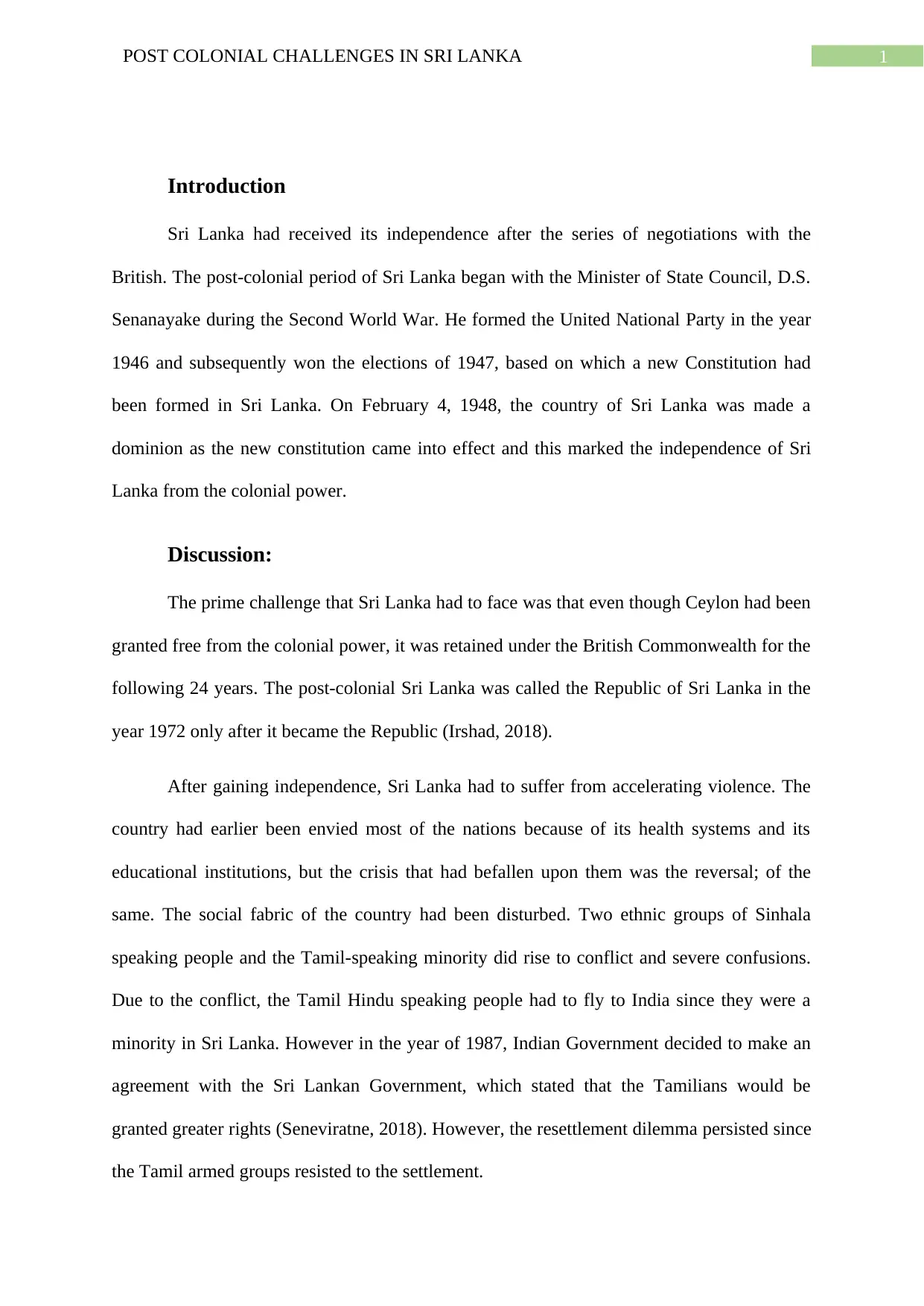
1POST COLONIAL CHALLENGES IN SRI LANKA
Introduction
Sri Lanka had received its independence after the series of negotiations with the
British. The post-colonial period of Sri Lanka began with the Minister of State Council, D.S.
Senanayake during the Second World War. He formed the United National Party in the year
1946 and subsequently won the elections of 1947, based on which a new Constitution had
been formed in Sri Lanka. On February 4, 1948, the country of Sri Lanka was made a
dominion as the new constitution came into effect and this marked the independence of Sri
Lanka from the colonial power.
Discussion:
The prime challenge that Sri Lanka had to face was that even though Ceylon had been
granted free from the colonial power, it was retained under the British Commonwealth for the
following 24 years. The post-colonial Sri Lanka was called the Republic of Sri Lanka in the
year 1972 only after it became the Republic (Irshad, 2018).
After gaining independence, Sri Lanka had to suffer from accelerating violence. The
country had earlier been envied most of the nations because of its health systems and its
educational institutions, but the crisis that had befallen upon them was the reversal; of the
same. The social fabric of the country had been disturbed. Two ethnic groups of Sinhala
speaking people and the Tamil-speaking minority did rise to conflict and severe confusions.
Due to the conflict, the Tamil Hindu speaking people had to fly to India since they were a
minority in Sri Lanka. However in the year of 1987, Indian Government decided to make an
agreement with the Sri Lankan Government, which stated that the Tamilians would be
granted greater rights (Seneviratne, 2018). However, the resettlement dilemma persisted since
the Tamil armed groups resisted to the settlement.
Introduction
Sri Lanka had received its independence after the series of negotiations with the
British. The post-colonial period of Sri Lanka began with the Minister of State Council, D.S.
Senanayake during the Second World War. He formed the United National Party in the year
1946 and subsequently won the elections of 1947, based on which a new Constitution had
been formed in Sri Lanka. On February 4, 1948, the country of Sri Lanka was made a
dominion as the new constitution came into effect and this marked the independence of Sri
Lanka from the colonial power.
Discussion:
The prime challenge that Sri Lanka had to face was that even though Ceylon had been
granted free from the colonial power, it was retained under the British Commonwealth for the
following 24 years. The post-colonial Sri Lanka was called the Republic of Sri Lanka in the
year 1972 only after it became the Republic (Irshad, 2018).
After gaining independence, Sri Lanka had to suffer from accelerating violence. The
country had earlier been envied most of the nations because of its health systems and its
educational institutions, but the crisis that had befallen upon them was the reversal; of the
same. The social fabric of the country had been disturbed. Two ethnic groups of Sinhala
speaking people and the Tamil-speaking minority did rise to conflict and severe confusions.
Due to the conflict, the Tamil Hindu speaking people had to fly to India since they were a
minority in Sri Lanka. However in the year of 1987, Indian Government decided to make an
agreement with the Sri Lankan Government, which stated that the Tamilians would be
granted greater rights (Seneviratne, 2018). However, the resettlement dilemma persisted since
the Tamil armed groups resisted to the settlement.
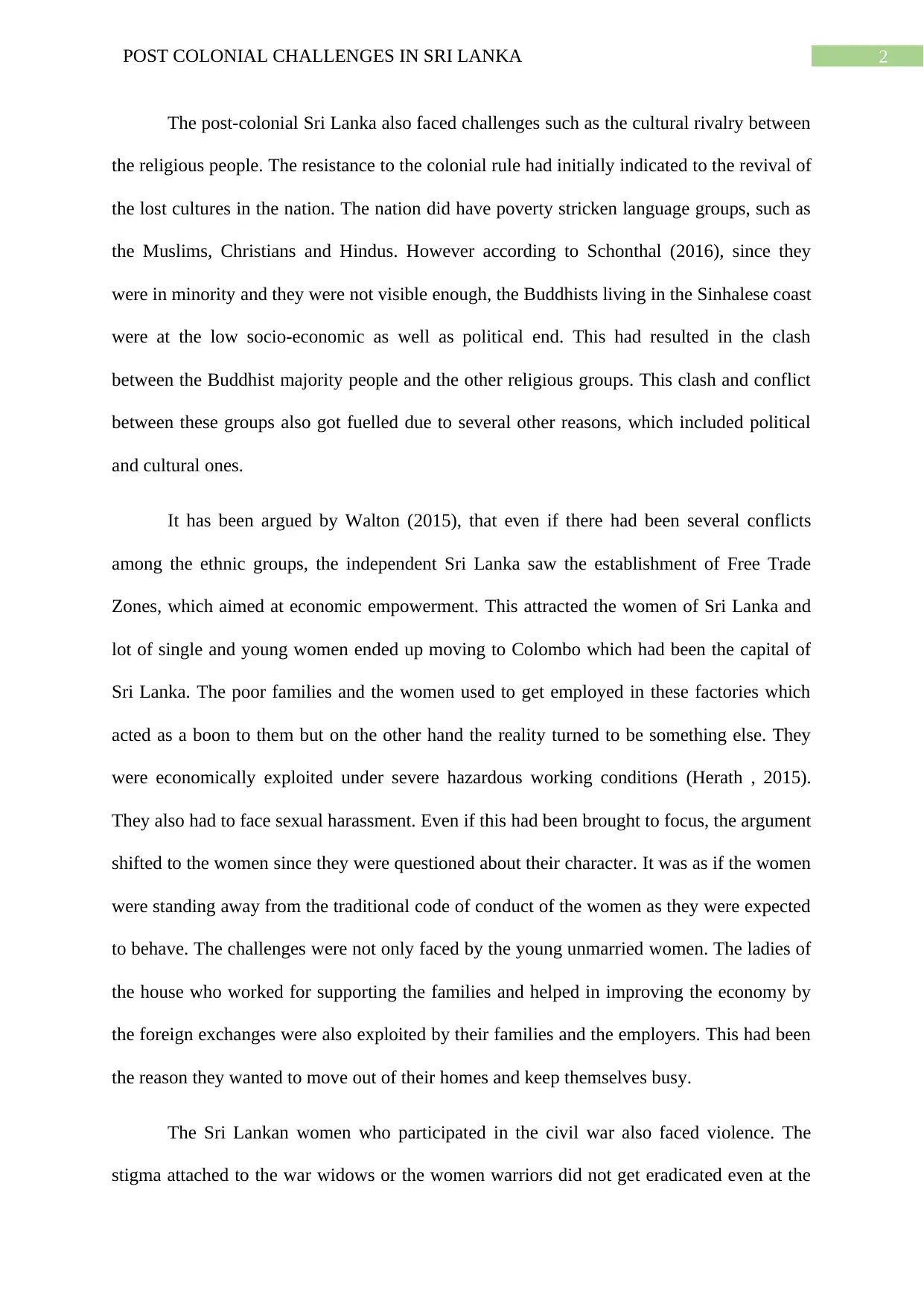
2POST COLONIAL CHALLENGES IN SRI LANKA
The post-colonial Sri Lanka also faced challenges such as the cultural rivalry between
the religious people. The resistance to the colonial rule had initially indicated to the revival of
the lost cultures in the nation. The nation did have poverty stricken language groups, such as
the Muslims, Christians and Hindus. However according to Schonthal (2016), since they
were in minority and they were not visible enough, the Buddhists living in the Sinhalese coast
were at the low socio-economic as well as political end. This had resulted in the clash
between the Buddhist majority people and the other religious groups. This clash and conflict
between these groups also got fuelled due to several other reasons, which included political
and cultural ones.
It has been argued by Walton (2015), that even if there had been several conflicts
among the ethnic groups, the independent Sri Lanka saw the establishment of Free Trade
Zones, which aimed at economic empowerment. This attracted the women of Sri Lanka and
lot of single and young women ended up moving to Colombo which had been the capital of
Sri Lanka. The poor families and the women used to get employed in these factories which
acted as a boon to them but on the other hand the reality turned to be something else. They
were economically exploited under severe hazardous working conditions (Herath , 2015).
They also had to face sexual harassment. Even if this had been brought to focus, the argument
shifted to the women since they were questioned about their character. It was as if the women
were standing away from the traditional code of conduct of the women as they were expected
to behave. The challenges were not only faced by the young unmarried women. The ladies of
the house who worked for supporting the families and helped in improving the economy by
the foreign exchanges were also exploited by their families and the employers. This had been
the reason they wanted to move out of their homes and keep themselves busy.
The Sri Lankan women who participated in the civil war also faced violence. The
stigma attached to the war widows or the women warriors did not get eradicated even at the
The post-colonial Sri Lanka also faced challenges such as the cultural rivalry between
the religious people. The resistance to the colonial rule had initially indicated to the revival of
the lost cultures in the nation. The nation did have poverty stricken language groups, such as
the Muslims, Christians and Hindus. However according to Schonthal (2016), since they
were in minority and they were not visible enough, the Buddhists living in the Sinhalese coast
were at the low socio-economic as well as political end. This had resulted in the clash
between the Buddhist majority people and the other religious groups. This clash and conflict
between these groups also got fuelled due to several other reasons, which included political
and cultural ones.
It has been argued by Walton (2015), that even if there had been several conflicts
among the ethnic groups, the independent Sri Lanka saw the establishment of Free Trade
Zones, which aimed at economic empowerment. This attracted the women of Sri Lanka and
lot of single and young women ended up moving to Colombo which had been the capital of
Sri Lanka. The poor families and the women used to get employed in these factories which
acted as a boon to them but on the other hand the reality turned to be something else. They
were economically exploited under severe hazardous working conditions (Herath , 2015).
They also had to face sexual harassment. Even if this had been brought to focus, the argument
shifted to the women since they were questioned about their character. It was as if the women
were standing away from the traditional code of conduct of the women as they were expected
to behave. The challenges were not only faced by the young unmarried women. The ladies of
the house who worked for supporting the families and helped in improving the economy by
the foreign exchanges were also exploited by their families and the employers. This had been
the reason they wanted to move out of their homes and keep themselves busy.
The Sri Lankan women who participated in the civil war also faced violence. The
stigma attached to the war widows or the women warriors did not get eradicated even at the
⊘ This is a preview!⊘
Do you want full access?
Subscribe today to unlock all pages.

Trusted by 1+ million students worldwide
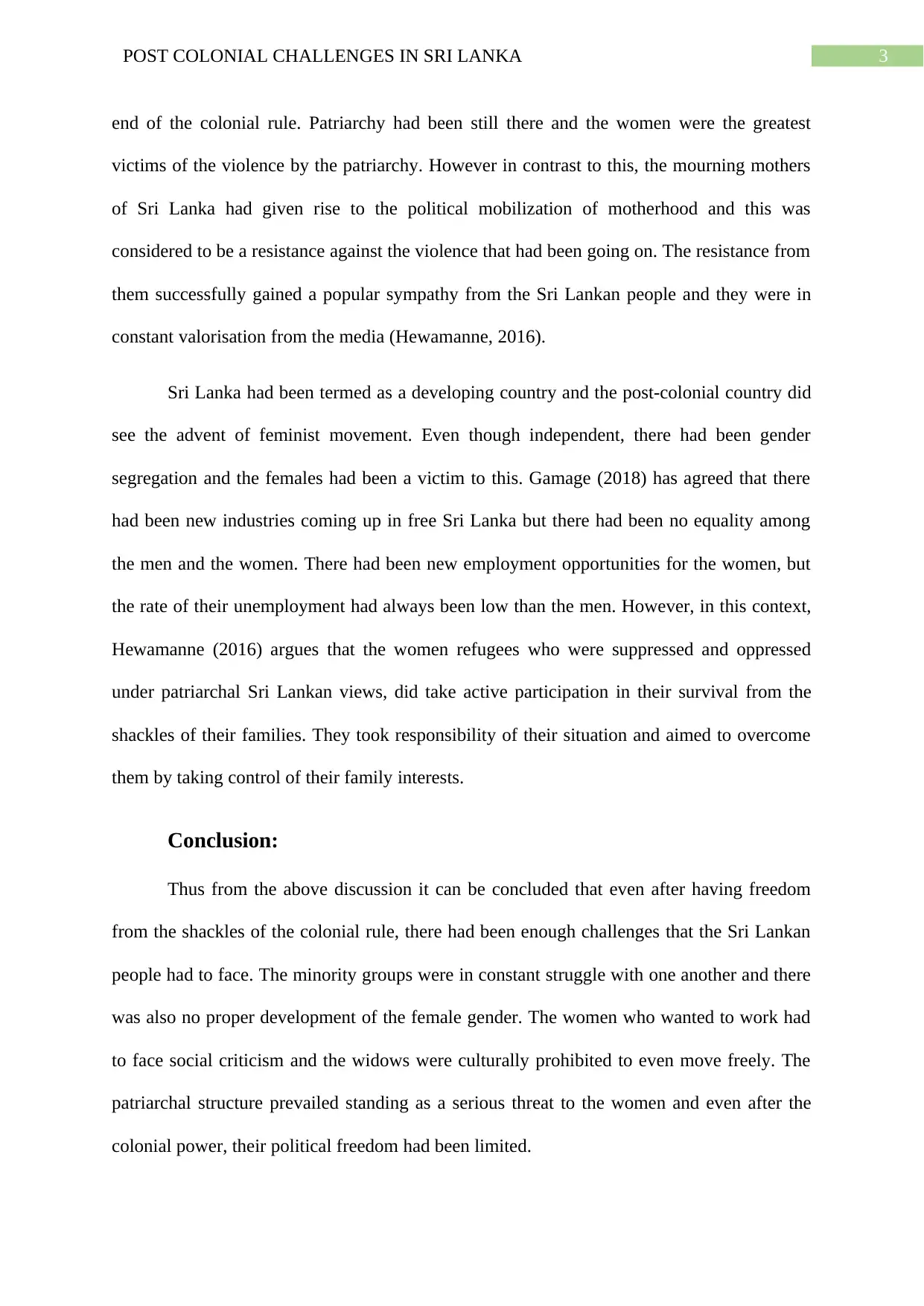
3POST COLONIAL CHALLENGES IN SRI LANKA
end of the colonial rule. Patriarchy had been still there and the women were the greatest
victims of the violence by the patriarchy. However in contrast to this, the mourning mothers
of Sri Lanka had given rise to the political mobilization of motherhood and this was
considered to be a resistance against the violence that had been going on. The resistance from
them successfully gained a popular sympathy from the Sri Lankan people and they were in
constant valorisation from the media (Hewamanne, 2016).
Sri Lanka had been termed as a developing country and the post-colonial country did
see the advent of feminist movement. Even though independent, there had been gender
segregation and the females had been a victim to this. Gamage (2018) has agreed that there
had been new industries coming up in free Sri Lanka but there had been no equality among
the men and the women. There had been new employment opportunities for the women, but
the rate of their unemployment had always been low than the men. However, in this context,
Hewamanne (2016) argues that the women refugees who were suppressed and oppressed
under patriarchal Sri Lankan views, did take active participation in their survival from the
shackles of their families. They took responsibility of their situation and aimed to overcome
them by taking control of their family interests.
Conclusion:
Thus from the above discussion it can be concluded that even after having freedom
from the shackles of the colonial rule, there had been enough challenges that the Sri Lankan
people had to face. The minority groups were in constant struggle with one another and there
was also no proper development of the female gender. The women who wanted to work had
to face social criticism and the widows were culturally prohibited to even move freely. The
patriarchal structure prevailed standing as a serious threat to the women and even after the
colonial power, their political freedom had been limited.
end of the colonial rule. Patriarchy had been still there and the women were the greatest
victims of the violence by the patriarchy. However in contrast to this, the mourning mothers
of Sri Lanka had given rise to the political mobilization of motherhood and this was
considered to be a resistance against the violence that had been going on. The resistance from
them successfully gained a popular sympathy from the Sri Lankan people and they were in
constant valorisation from the media (Hewamanne, 2016).
Sri Lanka had been termed as a developing country and the post-colonial country did
see the advent of feminist movement. Even though independent, there had been gender
segregation and the females had been a victim to this. Gamage (2018) has agreed that there
had been new industries coming up in free Sri Lanka but there had been no equality among
the men and the women. There had been new employment opportunities for the women, but
the rate of their unemployment had always been low than the men. However, in this context,
Hewamanne (2016) argues that the women refugees who were suppressed and oppressed
under patriarchal Sri Lankan views, did take active participation in their survival from the
shackles of their families. They took responsibility of their situation and aimed to overcome
them by taking control of their family interests.
Conclusion:
Thus from the above discussion it can be concluded that even after having freedom
from the shackles of the colonial rule, there had been enough challenges that the Sri Lankan
people had to face. The minority groups were in constant struggle with one another and there
was also no proper development of the female gender. The women who wanted to work had
to face social criticism and the widows were culturally prohibited to even move freely. The
patriarchal structure prevailed standing as a serious threat to the women and even after the
colonial power, their political freedom had been limited.
Paraphrase This Document
Need a fresh take? Get an instant paraphrase of this document with our AI Paraphraser

4POST COLONIAL CHALLENGES IN SRI LANKA
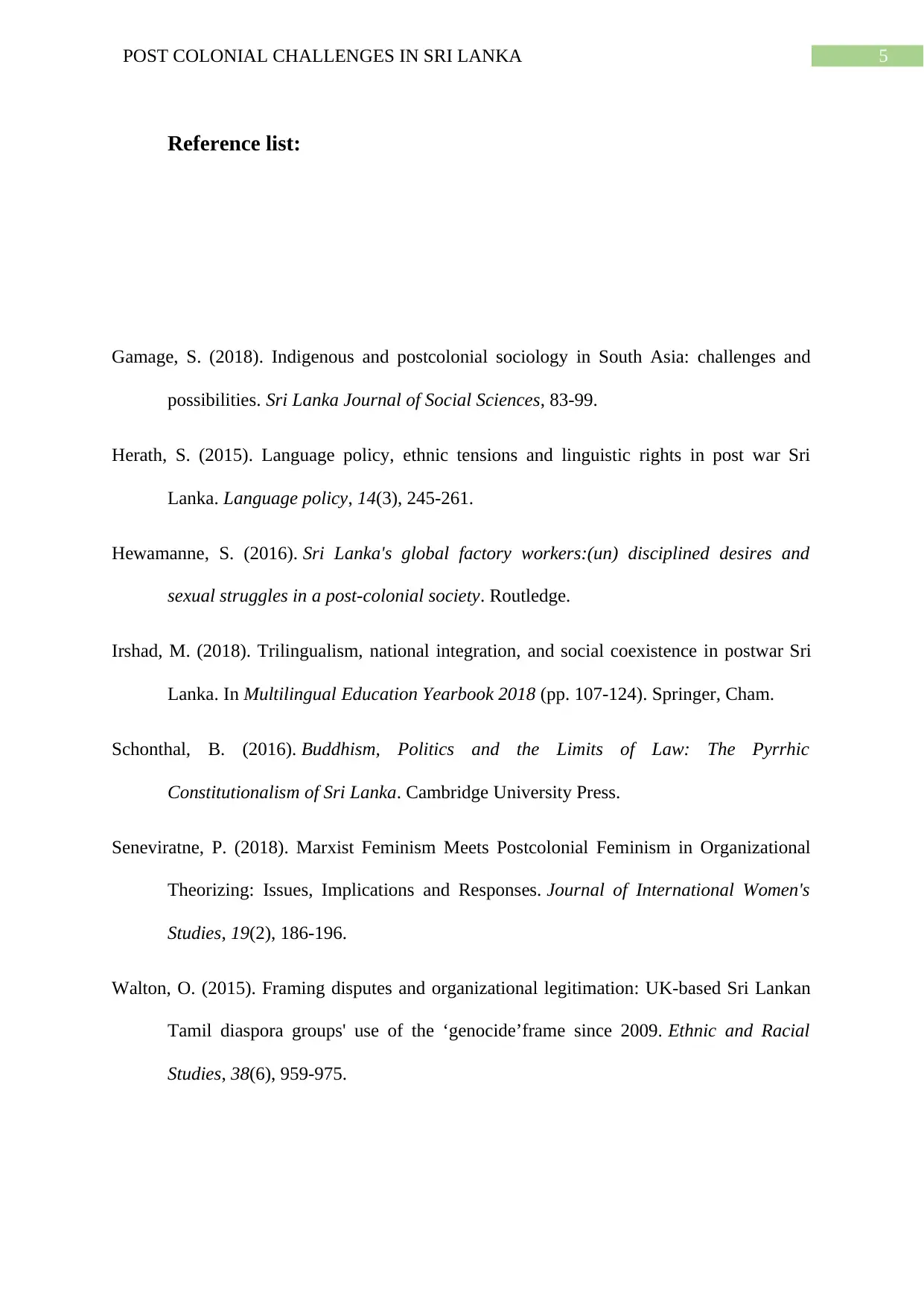
5POST COLONIAL CHALLENGES IN SRI LANKA
Reference list:
Gamage, S. (2018). Indigenous and postcolonial sociology in South Asia: challenges and
possibilities. Sri Lanka Journal of Social Sciences, 83-99.
Herath, S. (2015). Language policy, ethnic tensions and linguistic rights in post war Sri
Lanka. Language policy, 14(3), 245-261.
Hewamanne, S. (2016). Sri Lanka's global factory workers:(un) disciplined desires and
sexual struggles in a post-colonial society. Routledge.
Irshad, M. (2018). Trilingualism, national integration, and social coexistence in postwar Sri
Lanka. In Multilingual Education Yearbook 2018 (pp. 107-124). Springer, Cham.
Schonthal, B. (2016). Buddhism, Politics and the Limits of Law: The Pyrrhic
Constitutionalism of Sri Lanka. Cambridge University Press.
Seneviratne, P. (2018). Marxist Feminism Meets Postcolonial Feminism in Organizational
Theorizing: Issues, Implications and Responses. Journal of International Women's
Studies, 19(2), 186-196.
Walton, O. (2015). Framing disputes and organizational legitimation: UK-based Sri Lankan
Tamil diaspora groups' use of the ‘genocide’frame since 2009. Ethnic and Racial
Studies, 38(6), 959-975.
Reference list:
Gamage, S. (2018). Indigenous and postcolonial sociology in South Asia: challenges and
possibilities. Sri Lanka Journal of Social Sciences, 83-99.
Herath, S. (2015). Language policy, ethnic tensions and linguistic rights in post war Sri
Lanka. Language policy, 14(3), 245-261.
Hewamanne, S. (2016). Sri Lanka's global factory workers:(un) disciplined desires and
sexual struggles in a post-colonial society. Routledge.
Irshad, M. (2018). Trilingualism, national integration, and social coexistence in postwar Sri
Lanka. In Multilingual Education Yearbook 2018 (pp. 107-124). Springer, Cham.
Schonthal, B. (2016). Buddhism, Politics and the Limits of Law: The Pyrrhic
Constitutionalism of Sri Lanka. Cambridge University Press.
Seneviratne, P. (2018). Marxist Feminism Meets Postcolonial Feminism in Organizational
Theorizing: Issues, Implications and Responses. Journal of International Women's
Studies, 19(2), 186-196.
Walton, O. (2015). Framing disputes and organizational legitimation: UK-based Sri Lankan
Tamil diaspora groups' use of the ‘genocide’frame since 2009. Ethnic and Racial
Studies, 38(6), 959-975.
⊘ This is a preview!⊘
Do you want full access?
Subscribe today to unlock all pages.

Trusted by 1+ million students worldwide
1 out of 6
Your All-in-One AI-Powered Toolkit for Academic Success.
+13062052269
info@desklib.com
Available 24*7 on WhatsApp / Email
![[object Object]](/_next/static/media/star-bottom.7253800d.svg)
Unlock your academic potential
Copyright © 2020–2025 A2Z Services. All Rights Reserved. Developed and managed by ZUCOL.
